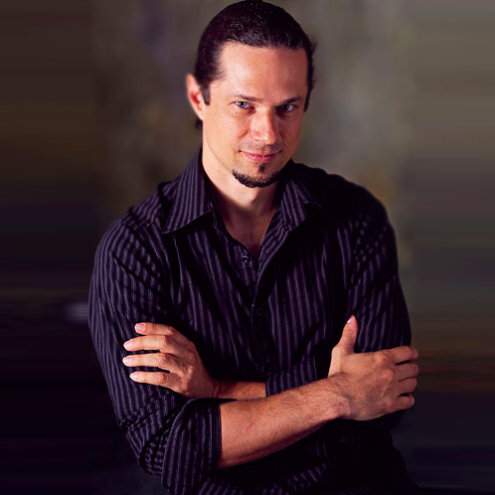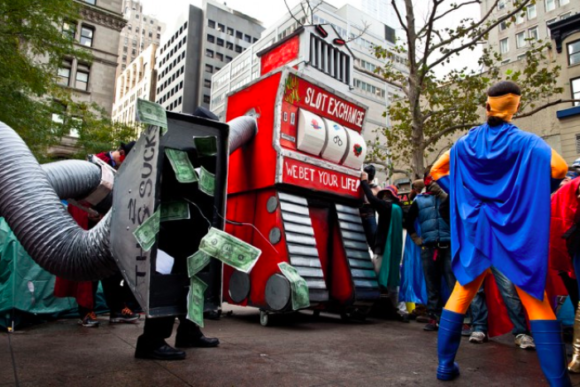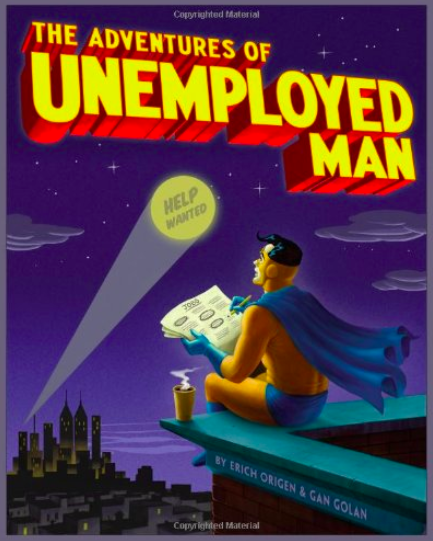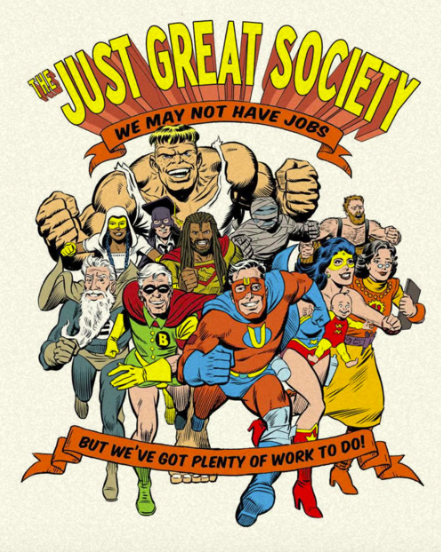
“If we can somehow observe the process that happens between a work of art and an idea reaching a community, and then that community taking a defiant form of action, that’s the black box. That’s where the great mystery is happening in these beautiful, unbelievable processes of moving from meaning to building relationships, to building power to taking action. That’s where I would love to be able to peer in more clearly.”
Gan Golan is a New York Times Bestselling Author, Artist & Agitator. His most recent works include the bestselling children’s book parody Goodnight Bush, and The Adventures of Unemployed Man, the critically-acclaimed graphic novel about the economic crisis. He has 20 years experience as a grassroots activist, having worked on issues from housing, to policing, to global justice, and militarism. He has created giant Mayan God protest puppets with indigenous collaborators in Mexico, and dropped 4-story banners from buildings with supergeeks at MIT.
George Perlov: So Gan, it seems as if you are everywhere. What’s up with that?
Gan Golan: I work independently for the most part. I’m affiliated with a lot of really great people on an ad hoc basis depending on the action, the opportunity that’s in front of us. I’ve worked with The Yes Men, I’ve worked with Citizen Engagement Lab, I was part of The Culture Group, and their Waves Report, and I was the training director for Beautiful Trouble for awhile.
My training is as a visual artist and performance art, kind of performance interventions. You know, I have my own arts practice as well, but it’s really trying to look at where these mass social movements and creative practice intersect.
GP: Right. So talk to me about these intersections.
GG: Yeah. These are overlapping communities. We connect with people who have learned a lot from each other as people experiment with this stuff. I think I come down on the social movement end of the spectrum, and I don’t work as much with, I think, groups that are affiliated with the art world. I think for me it’s about how creative practice works in service of social movements, where I think, at least at this moment in history and the challenges we face, are the most important places we can have impact, and so I’m very interested in acting in the role of creative activist within popular social movements. And I also work with another group called the Movement NetLab, which is really a think tank that came out of Occupy and Black Lives Matter, and it’s really looking at trying to understand the kind of underlying structures that often govern the success of mass popular social movements.
GP: Okay. Is there a basic process that you use for your trainings? Or is it more fluid than that?
GG: For me, it’s pretty fluid. There’s now a broad range of different tools that have been developed by this landscape of creative activists, which I think is fantastic, but it also means that we have a toolbox from which to draw from to figure out what tool is going to fly for each challenge. It might be very different. It looks very different in different situations. Whether it’s grassroots community-based stuff, as opposed to people who have never worked with creative activism before and are very much at the beginning of their own organizing, but just have a very urgent fight that they’re involved in; to working with large coalitions of as-you-go’s, who are trying to organize a maximal organization of hundreds of thousands of people and already have a bunch of media people and everything in place. And you’re really trying to help them jump tracks into a different way of strategizing and making a creative activist practice.
GP: What is a creative activist place to you? How does it offer a different impact?
GG: Yeah. Well, I think, particularly because of my orientation looking at mass social movements, which I think are a key entrance to driving change right now, but I think there are some practical – not necessarily my personal preferences – practical reasons that we’re focused on. I think they ask us different questions about what impact is and where to look for it.
GP: That’s interesting that your personal preferences don’t align with some of the practical reasons of social movements. In terms of its impact then, where do you look for it?
GG: I think it can be useful to reframe what we mean by ‘an act’. It’s often different than the way that we have tried to look at it. I think that when you talk about artistic activism – that artistic activism is the nexus between creating meaning and building power. These two very different practices that, when they intersect, can become very powerful. And it’s really about channeling collective energy on a massive level, which is different than some of the individualized waves of personal transformation or shifting someone’s opinion or all of those things which we sometimes try to look at for impact.

From the People’s Climate March, 2014
GP: Okay, so what I’m understanding is that impact is different on a larger scale than an individual one. How does that differentiation apply to work you’ve done?
GG: Another group that I’m associated with is People’s Climate Arts. It came out of the group that helped design the People’s Climate March, which is the largest climate globalization in history that happened in New York City in 2014, in which we were successful in really putting creative activism at the very center of the strategy for the entire organizing effort. That was a major shift because we were dealing with a large coalition of big power players. So, we were very entrenched in an area with loads of organizing. What that meant to them we got them to make a shift, and the shift proved revolutionary for their practice. We got 400,000 people in the streets, and we communicated in an entirely different way what climate activism meant and who really was at the forefront of the Climate movement. I think we reframed what the environmental activism is in the United States. It was a pivotal moment.
GP: That’s amazing. How did that happen?
GG: I think a lot of it had to do with the narrative strategy of the creative organizing that was at the center of it. And what we came out with is the idea that creative activism or artistic organizing can be many things, we felt we really exceeded in understanding that art is an organizing strategy, and to organize those. Everybody does this differently and there are some ways to do them better. And that’s different than artistic journalism, art as personal transformation – all these other important things that art can do.
GP: How does artistic and creative activism fall in line with art and traditional activism?
GG: So for us, yes, it was phoning people, inspiring people, but it was also about mobilizing people, engaging people on a very large, broad level. And then, building the relationships between those people and getting them into new forms of work. And so, to build relationships is relational organizing. It is really kind of the covalent bonds that allow individuals to form into things that have power.
GP: In building relationships between people, how did that change the impact of the project?
GG: The art played a really significant role in that. And yeah, you can zoom in on the individual level and look at the way opinion was shifted or think of self- transformation or things like that, but what we were really able to see was how this was operating collectively at a very large scale, and creating new webs of relationships that many of them are doing to this day – a number of organizations came out of that effort, as well as things like shifting the popular narrative around these issues.
So, I guess the short answer is: I think that we need more metrics around collaborative mobilization about relational density, looking at the densification of relationships within certain communities that are engaged in the creative practice, as well as a marriage just on a large scale. If we want to see how a new narrative was injected into the popular discourse, that’s a really interesting question and I think there are some answers to some degree. But to the degree that people have attempted to look at that — I think there’s a really interesting site on the way different firms started to become big within the media. There was a LexisNexis search done around income equality in 2011. And the economic crisis started in 2008. And really, there wasn’t a whole lot of talk about it, but suddenly Occupy happened. There’s a massive proliferation of the term “income equality” through the media that almost dovetails perfectly to the day of the kind of public life of the Occupy movement. So, you could see Occupy as a kind of form of public performance art, really, as a creative intervention itself.

From Occupy Wall Street, 2011
GP: How does creative intervention change or assist the movement?
GG: Political theater, or whatever we want to call it, really helped generate this entire – it injected an entirely new conversation into the public discourse in a really powerful way. And I think there could be lots of other interesting ways to measure that, but the kind of ways in which creating meaning really starts to be visible and seen on that collaborative level. You could also see the proliferation of hashtags for more complex narratives around climate change. I would love to see people do studies around these new areas that were introduced during the Climate March that had previously not been talked about, and environmental stuff like climate change and immigration, for example. There was a huge section of the march designed around that. The whole march was designed as a story from beginning to end. So a 20-block-long story with 400,000 people in it, which is very different to the way marches are organized.
I also think that it would be really interesting to see more of a focus on the way that new identities – collective identities, political identities – are created, and I think a lot of that has to do with artistic practice. And when you look at Occupy as an identity, right, Black Lives Matter as an identity, Creative Defenders as an identity, you see that people are highly motivated to take action because basically they have internalized that identity. It has become meaningful to them. But it’s something that is shared with other people.
GP: Okay. So if I’m correct in what I’m hearing from you, impact can be assessed at at two levels: the ability of changing the organizations and how they do their work, and also in terms of narrative, how the narrative changes in the public and/or leads or whomever it is.
GG: Yeah. The language changing, but also the impact is creating – and I think this notion of identity is really, really important. Because these are invented identities, these are artistic acts that are then popularized by the idea that we are a part of this thing, that is X, and it means it is a very specific thing to be a part of.
I think, if you look at the history of the labor movement, so much of the art and culture that accompanied it was about: Who we are as a labor movement and as a working class people? There was a class identity. It was about union membership. It wasn’t just about contract fights and negotiations and policy to try a popular idea, it was about redefining who is the “we” and who is the “they,” you know, and creating that story that people were then living with the activism.
Cultural organizing is nothing new. Religion has done it for thousands of years. Political parties have done it since their existence. And these are very much around the idea of forming collective meaning. The way art is practiced as it happens now in the contemporary setting, is it’s very much about the individual – the individual artist, the individual audience member having some sort of personal transformation, and I think that’s been a huge liability, actually, to the left. And we can see these tensions erupt very quickly when artists try to work with organizers and they don’t have a great understanding of each other.

Cover of The Adventures of Unemployed Man by Gan Golan and Erich Origen
GP: I can imagine. Going back to measuring impact – are there some groups who are doing a good job of this do you think in the field? Or what’s your sense?
GG: I haven’t seen – and again, I’m not nearly as close to it as other people – I haven’t looked at this stuff for a couple of years. But I have not seen anything that really blew my mind in terms of: “Oh, that’s what we’re looking for.” But also, for me, there’s also a question of: who are we trying to convince, and of what? Are we trying to convince funders? Are we trying to convince economists? Are we trying to convince advocacy organizations? And to do what? To spend more money on this stuff? You know, to respect the role of art and culture? Those are part of my questions.
GP: Well, let me ask you this: Who do you think is driving the process? Is it the funders or academics, or others who are interested in that? Or where is the energy coming from on this topic?
GG: I feel that I’ve seen advocacy organizations try to get more funding making the case to a lot of tone-deaf and culturally deaf organizations to spend more money on culture. And then I have also seen people in the entertainment complex trying to make the case for this stuff to then integrate more of this stuff and put it into popular media, popular culture. But I do think in doing that we often miss what is really working.
We no longer have to talk about this in theory — we can point to a few examples. The two major shifts we’ve had, and the call to discourse on the progressive side of things in the last decade, have been Occupy and Black Lives Matter – equality and racial injustice. And those came from outside the advocacy structures, outside the established media structures, outside the unions. But interestingly enough, artists have been very central and pivotal to both of these movements. If you look at the people who are leaders in these movements, even though they may not be known publicly as artists, these are not people with law degrees or MBAs. Some of them have an academic background, but they’re not PhDs. They are people with a lot of background in creative and artistic practice. And I think what they are doing is pitching to their community or to a larger public different narratives that create a sense of meaning to help organize the people’s sense of frustration and injustice in a coherent way. That is a creative act.
GP: Right.
GG: And they’re practicing it on a massive level. They’re not creating any identifiable piece of culture. They’re not creating movies, you know. And that’s where I think that has been, and I don’t know if anyone is mentioning that other than, you know, social media, something like that, which I think are useful, but they’re not getting at the heart of why these things are meaningful and powerful and mobilize human labor on a massive scale towards a particular goal.
GP: You’ve brought up both Occupy and Black Lives Matter. I’m curious to hear what your take is on why they were successful. What did they do that you feel you’ve seen impact?
GG: Right. Well, first of all they created a narrative in a vacuum where people were having a very difficult and painful lived daily experience, around which there was no narrative to really explain being offered by popular culture or the State about why their experience differed so much from the popular discourse. They were being told one thing and experiencing another thing entirely. And that vacuum of meaning is an incredibly fertile area for any kind of opportunist to intervene.
If people’s experience is dramatically different from the narrative that they’re given to understand that experience, someone is going to offer a new narrative. And that narrative, that web of meaning is going to tell them who they are, who they are fighting against, what they are fighting for, and how they should do it. And whoever can come in and offer that framework in a way that actually makes sense based upon what people already know, is going to be able to mobilize people on that scale, and I think Occupy did that. I think the Tea Party did that. I think Black Lives Matter has done that.
GG: Okay, so ultimately they’re successful because they’ve been able to mobilize people to do something differently. Or do something.
GG: Yes, but in a meaningful way. It’s told them something about who they are and given them a sense of agency in that story.

Page from The Adventures of Unemployed Man, Gan Golan and Erich Origen
GP: I guess the other question I have is about the assessment and evaluation of all of this. Is it assessment part of your planning and training process when you’re working with groups? Do you set goals and objectives with them or how does that work when you’re working with an organization?
GG: You typically find metrics that match the most important aspect of this process. I don’t use them. And the reason is that I think – I don’t know if you ever saw the famous “I Love Lucy” episode, and it’s an old vaudeville joke, but Ricky comes in and Lucy’s crawling around on the floor looking through the carpet. Ricky is like, “What are you doing? What are you looking for?” And she says, “I lost my earrings.” And he says, “where did you lose them?” And she says “in the bedroom.” And he says “well, why are you looking or them here?” And she says “because the light is better.” It’s a classic joke I think it says a lot about metrics, which is that we often look where the light is rather than where the answer is.
I think where we keep it clearest is where we start to focus a lot of our activity. I think a lot of the conversation on metrics has been actually damaging because the things that are the most measurable are sometimes the least important. And I think that the most important are the least measurable. And as a result, the metrics and the money and support and the institution building all go in the other direction. I think the most important things we can be doing needs less support.
I actually think this explains a huge amount of the diversion of the left for the last 30 years into professional forms of organizing that have depleted the things that are actually effective and meaningful. And that’s why most of the collective organizing that I see that is really shifting the discourse is coming almost totally outside of the professional vendors. We built up a nonprofit industrial complex for 30 years, and it coincided with total increase in the power of the left. And then these breakthroughs are happening from almost totally outside the system that we created in order to address the problem. So I think there can be a danger, actually, in pursuing kind of metrics as a means to target the work that we do.
GP: Can you give an example of something that is measurable but maybe not that important? A lot of folks talk about success in terms of how much social media coverage they get. Likes and clicks.
GG: Yeah, I think social media is actually a stepping stone metric. Because it’s the first time we’ve actually able to measure the way in which people are responding to something on a massive level. So I think it’s a really important metric, but then people are just saying, well how can we get more hits, how can we get more views? And then there are all kinds of artificial ways to create that. So people are going after the metric rather than the thing that actually causes the metric.
So, people are gaming the system and then looking at their own false results as examples as having impact. So, we’re tricking ourselves in the lab, so to speak. I don’t think we have yet found metrics that really show meaning, but I do think that when you see massive levels of people willing to undertake risk, willing to exert their energy, particularly when they’re not being compensated by anything else, that’s when you start to see human meaning being actualized in concrete form. Meaning is what motivates people to do the work.
GP: Does it matter if these programs are effective or not?
GG: I think it matters if they’re effective, of course. But it really depends on how we define “effective” and “impact” – all of these things. Like I was saying, we’re often looking in not the most potent places. And I’d certainly like to measure places where it is most potent. So I do think it matters that it works, but I think artists are often accused of doing things that don’t matter because they are intuitively doing things that are meaningful and makes sense to them that are not measurable.
So in doing so, sometimes they may be plugging into something that is incredibly powerful and important. So I would encourage people to keep doing things that don’t matter to others the way that we define them, because we’re reaching out into that dark, undefinable place in which so much of human experience actually happens. These are the key places in which people often are motivated to change. So yes, keep doing things that “don’t matter” because that is likely the place that matters most.
GP: So, given your suspicion about metrics and what they are actually measuring, do you think there is any value in assessment, in theories of change, or impact measurement?
GG: Yes, if it can help us see into some of those black boxes, some of the dark areas. We’re trying to see the dark matter that’s out there and detect it and really understand it. If we can somehow observe the process that happens between a work of art and an idea reaching a community, and then that community taking a defiant form of action, that’s the black box. That’s where the great mystery is happening in these beautiful, unbelievable processes of moving from meaning to building relationships, to building power to taking action. That’s where I would love to be able to peer in more clearly.




You must be logged in to post a comment.